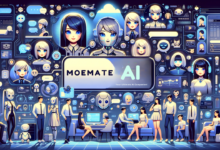Understanding Motion AI: The Future of Technology

In today’s fast-paced world, technology is evolving at an astonishing rate, and one of the most exciting advancements is in the realm of motion AI. Imagine walking into a room, and the lights dim automatically, your favorite music starts playing, and the temperature adjusts to your comfort level—all without you lifting a finger! This isn’t just science fiction; it’s the reality that motion AI is making possible. In this article, we’ll dive deep into what motion AI is, its applications, benefits, and how it’s changing the way we interact with our environment.
What is Motion AI?
Motion AI refers to artificial intelligence systems that can recognize and respond to motion. This technology integrates computer vision, machine learning, and robotics to create systems capable of interpreting and reacting to human actions in real time. From smart homes to advanced robotics, motion AI is paving the way for a more interactive and intuitive world.
Key Components of Motion AI
- Computer Vision: This is the backbone of motion AI. It enables machines to interpret visual information from the world, allowing them to recognize objects, track movements, and even understand facial expressions.
- Machine Learning: This aspect will enable systems to learn from data. The more a motion AI system observes, the better it becomes at predicting and responding to human actions.
- Sensors: Motion detection often relies on various sensors, such as cameras and infrared detectors, which capture data about movements in their surroundings.
Applications of Motion AI
The potential applications of motion AI are vast and varied. Here are some areas where this technology is making waves:
Smart Homes
- Automated Lighting: Motion AI can control lighting based on human presence. When you enter a room, lights turn on automatically and adjust based on your movements.
- Temperature Control: Thermostats equipped with motion sensors can learn your habits and adjust the temperature to keep you comfortable.
Healthcare
- Patient Monitoring: In hospitals, motion AI can track patient movements to ensure they receive timely care. It can alert staff if a patient falls or requires assistance.
- Robotic Surgery: Surgeons can use motion AI to guide robotic arms with precision, leading to safer and more effective procedures.
Retail
- Customer Interaction: Retailers can use motion AI to analyze customer movements and preferences, optimizing store layouts for better shopping experiences.
- Inventory Management: Systems can monitor stock levels and alert staff when items need restocking based on customer activity.
Robotics
- Autonomous Vehicles: Motion AI plays a crucial role in enabling self-driving cars to detect obstacles, recognize traffic signals, and navigate complex environments.
- Drones: Drones equipped with motion AI can conduct surveillance, deliver packages, and even assist in search-and-rescue operations.
Benefits of Motion AI
The advantages of adopting motion AI technologies are numerous and impactful. Here’s a closer look at why this innovation is so beneficial:
Enhanced Efficiency
- Time-Saving: Automated systems reduce the need for manual adjustments, freeing up time for individuals to focus on more important tasks.
- Error Reduction: With machines handling routine tasks, the potential for human error decreases, leading to more consistent results.
Improved Safety
- Increased Surveillance: Motion AI systems can monitor environments for unusual activity, enhancing security in public spaces and homes.
- Quick Response: In healthcare settings, motion AI can alert staff to emergencies in real time, potentially saving lives.
Better User Experience
- Personalized Interactions: Motion AI allows devices to adapt to user preferences, creating a more enjoyable and tailored experience.
- Seamless Integration: With motion AI, different devices and systems can communicate, leading to a more cohesive technological ecosystem.
The Future of Motion AI
As we look to the future, the potential for motion AI seems limitless. Here are some trends and predictions that could shape the landscape:
Advancements in Technology
- Improved Algorithms: As machine learning algorithms become more sophisticated, motion AI systems will be able to recognize and respond to a wider range of movements and contexts.
- Integration with Other Technologies: Motion AI will likely be combined with other AI technologies, such as natural language processing, to create even more intuitive systems.
Greater Accessibility
- Affordable Solutions: As the technology becomes more widespread, we can expect to see affordable motion AI solutions that can be integrated into everyday devices, making them accessible to everyone.
- Education and Training: Schools and educational institutions will likely incorporate motion AI into their curriculums, preparing the next generation for a tech-savvy future.
Challenges Facing Motion AI
While motion AI presents exciting opportunities, it’s important to recognize the challenges that come with it:
Privacy Concerns
- Data Security: With motion AI systems continuously collecting data, concerns about how this information is stored and used are paramount.
- Surveillance Issues: The potential for misuse of motion AI in surveillance raises ethical questions about privacy rights.
Technical Limitations
- Accuracy: Current motion AI systems can sometimes misinterpret actions, leading to frustration for users.
- Environmental Constraints: Factors such as lighting and obstructions can affect the performance of motion AI systems.
Motion AI in Action: Real-World Examples
To understand the impact of motion AI, let’s explore some real-world applications and how they’ve made a difference:
Example 1: Amazon Go
Amazon Go stores use motion AI to create a cashier-less shopping experience. Shoppers can walk in, pick items off the shelves, and walk out. The system tracks what customers take and charges them automatically, offering a seamless shopping experience.
Example 2: Smart Homes by Google
Google’s smart home devices utilize motion AI to enhance user experience. For instance, the Nest thermostat learns your schedule and preferences, adjusting the temperature accordingly. It also senses when you’re home or away, optimizing energy use without any manual input.
Conclusion: Embracing the Future of Motion AI
In conclusion, motion AI is not just a trend; it’s a significant leap toward a smarter and more efficient future. From transforming our homes to revolutionizing healthcare and retail, the possibilities are endless. While challenges remain, the benefits of motion AI are clear, and its potential to enhance our daily lives is incredibly optimistic.
As we embrace this technology, we can look forward to a world where our interactions with machines are more intuitive, our environments are safer, and our experiences are more personalized. The future is bright with motion AI, and it’s exciting to think about how this technology will continue to evolve and improve our lives.





